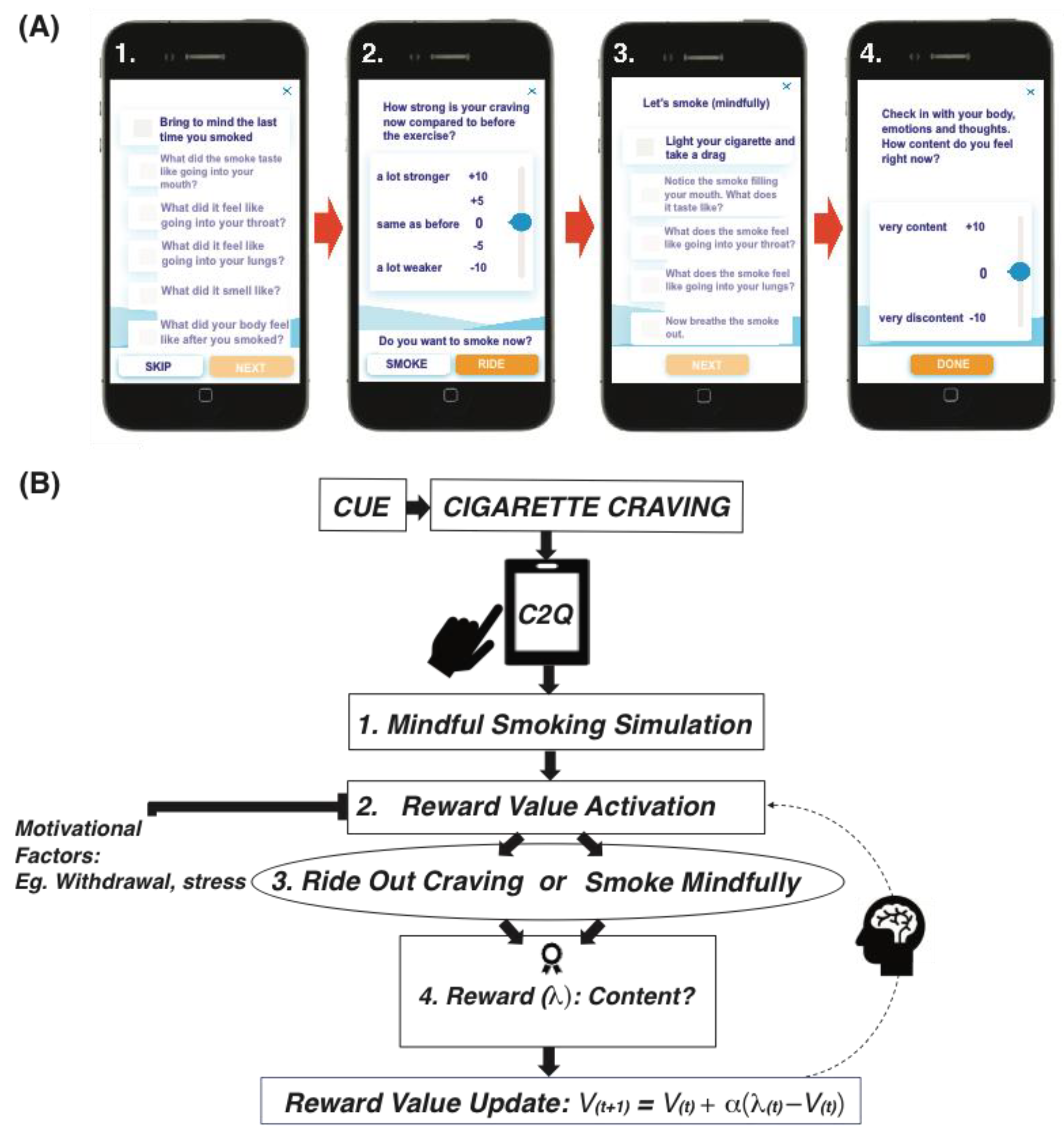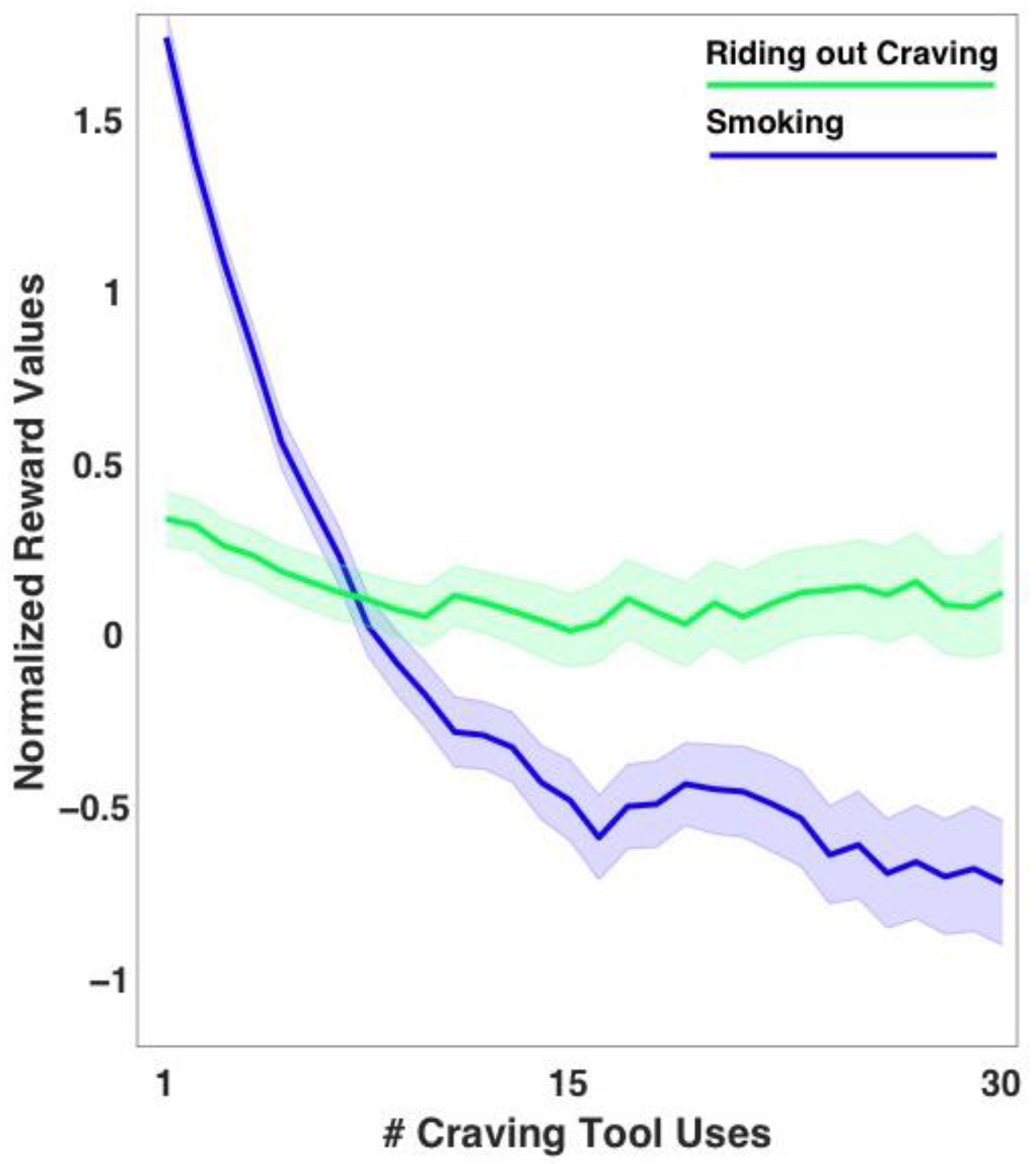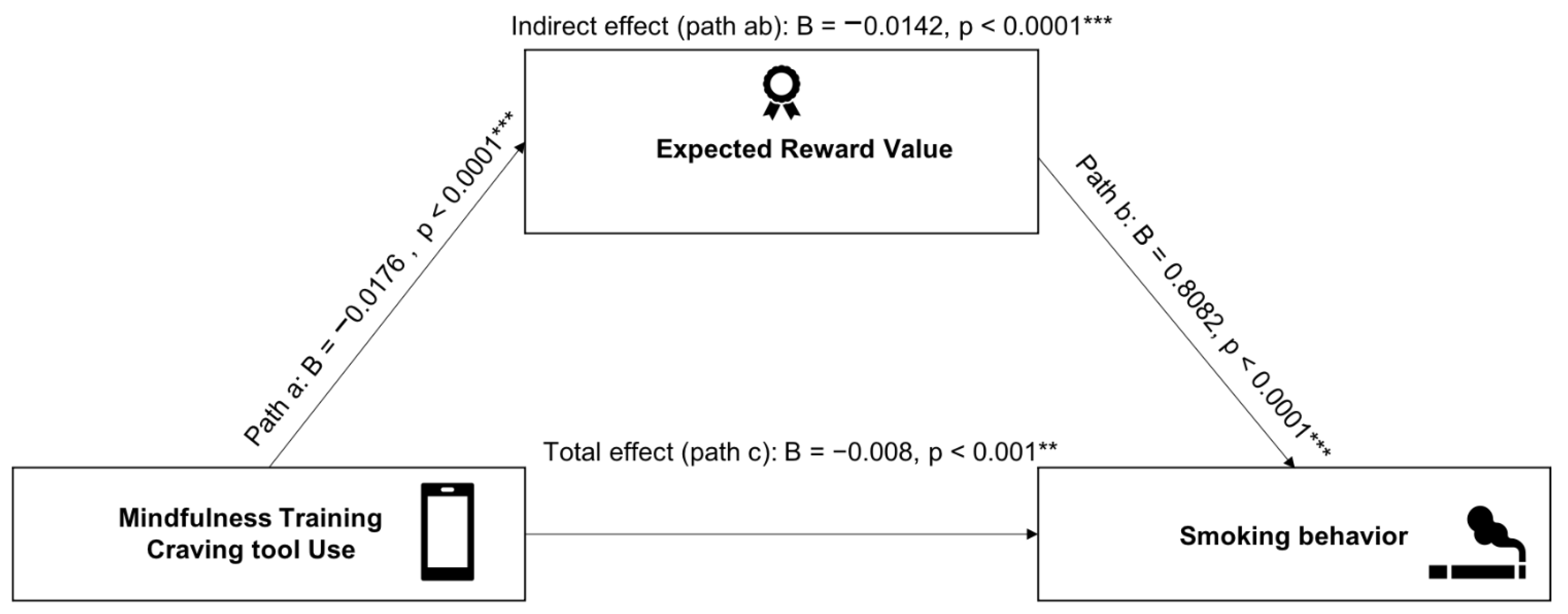App-Based Mindfulness Training Predicts Reductions in Smoking Behavior by Engaging Reinforcement Learning Mechanisms: A Preliminary Naturalistic Single-Arm Study
Abstract
:1. Introduction
2. Materials and Methods
2.1. Participants
2.2. Craving to Quit (C2Q) Program: Mobile Mindfulness Training with Experience Sampling
2.3. Measures
2.3.1. Demographic and Intervention Completion Variables
2.3.2. Present-Moment Reward Values
2.3.3. Smoking Behavior
2.3.4. Contentment from Smoking or Riding Out Cravings
2.3.5. Expected Reward Values from Smoking
2.4. Data Analysis
2.4.1. Learning Model Descriptions
2.4.2. Model Comparison and Selection
2.4.3. Multi-Level Mediation and Regression Analyses
3. Results
3.1. Trajectories across Craving Tool Uses for Expected Reward Value of Smoking and Not Smoking
3.2. Expected Reward Value Mediates the Relationship between Craving Tool Uses and Smoking Behavior
3.3. Expected Reward Values Predict Present-Moment Reward Values
4. Discussion
5. Conclusions
Author Contributions
Funding
Institutional Review Board Statement
Informed Consent Statement
Data Availability Statement
Acknowledgments
Conflicts of Interest
References
- WHO Report on the Global Tobacco Epidemic; World Health Organization: Geneva, Switzerland, 2020.
- Smoking Cessation: A Report of the Surgeon General; U.S. Department of Health and Human Services, Centers for Disease Control and Prevention, National Center for Chronic Disease Prevention and Health Promotion, Office on Smoking and Health: Atlanta, GA, USA, 2020.
- Perkins, K.A.; Conklin, C.A.; Levine, M.D. Cognitive-Behavioral Therapy for Smoking Cessation: A Practical Guidebook to the Most Effective Treatments; Routledge Taylor & Francis Group: New York, NY, USA, 2008. [Google Scholar]
- Law, M.; Tang, J.L. An analysis of the effectiveness of interventions intended to help people stop smoking. Arch. Intern. Med. 1995, 155, 1933–1941. [Google Scholar] [CrossRef] [PubMed]
- Fiore, M.C.; Bailey, W.C.; Cohen, S.J. Treating Tobacco Use and Dependence: Clinical Practice Guideline; U.S. Department of Health and Human Services: Washington, DC, USA, 2000. [Google Scholar]
- Denison, E.; Underland, V.; Mosdøl, A.; Vist, G.E. Cognitive Therapies for Smoking Cessation: A Systematic Review; Norweigan Institute of Public Health: Oslo, Norway, 2017. [Google Scholar]
- Piasecki, T.M. Relapse to smoking. Clin. Psychol. Rev. 2006, 26, 196–215. [Google Scholar] [CrossRef] [PubMed]
- Brewer, J.A.; Elwafi, H.M.; Davis, J.H. Craving to quit: Psychological models and neurobiological mechanisms of mind-fulness training as treatment for addictions. Psychol. Addict. Behav. 2013, 27, 366–379. [Google Scholar] [CrossRef] [PubMed] [Green Version]
- Bevins, R.A.; Palmatier, M.I. Extending the Role of Associative Learning Processes in Nicotine Addiction. Behav. Cogn. Neurosci. Rev. 2004, 3, 143–158. [Google Scholar] [CrossRef] [Green Version]
- Thorndike, E.L. A Proof of the Law of Effect. Science 1933, 77, 173–175. [Google Scholar] [CrossRef]
- Prochaska, J.J.; Benowitz, N.L. Current advances in research in treatment and recovery: Nicotine addiction. Sci. Adv. 2019, 5, eaay9763. [Google Scholar] [CrossRef] [Green Version]
- Miller, K.J.; Shenhav, A.; Ludvig, E.A. Habits without values. Psychol. Rev. 2019, 126, 292–311. [Google Scholar] [CrossRef]
- de Souza, I.C.W.; de Barros, V.V.; Gomide, H.P.; Miranda, T.C.M.; de Paula Menezes, V.; Kozasa, E.H.; Noto, A.R. Mindfulness-based interventions for the treatment of smoking: A systematic literature review. J. Altern. Complement Med. 2015, 21, 129–140. [Google Scholar] [CrossRef]
- Oikonomou, M.T.; Arvanitis, M.; Sokolove, R.L. Mindfulness training for smoking cessation: A meta-analysis of randomized-controlled trials. J. Health Psychol. 2017, 22, 1841–1850. [Google Scholar] [CrossRef]
- Maglione, M.A.; Maher, A.R.; Ewing, B.; Colaiaco, B.; Newberry, S.; Kandrack, R.; Shanman, R.M.; Sorbero, M.E.; Hempel, S. Efficacy of mindfulness meditation for smoking cessation: A systematic review and meta-analysis. Addict. Behav. 2017, 69, 27–34. [Google Scholar] [CrossRef]
- Bowen, S.; Marlatt, A. Surfing the urge: Brief mindfulness-based intervention for college student smokers. Psychol. Addict. Behav. 2009, 23, 666–671. [Google Scholar] [CrossRef] [PubMed]
- Garland, E.L. Restructuring reward processing with Mindfulness-Oriented Recovery Enhancement: Novel therapeutic mechanisms to remediate hedonic dysregulation in addiction, stress, and pain. Ann. New York Acad. Sci. 2016, 1373, 25–37. [Google Scholar] [CrossRef]
- Froeliger, B.; Mathew, A.; McConnell, P.A.; Eichberg, C.; Saladin, M.E.; Carpenter, M.J.; Garland, E.L. Restructuring Reward Mechanisms in Nicotine Addiction: A Pilot fMRI Study of Mindfulness-Oriented Recovery Enhancement for Cigarette Smokers. Evidence-Based Complement. Altern. Med. 2017, 2017, 7018014. [Google Scholar] [CrossRef] [PubMed]
- Brewer, J.A. Mindfulness training for addictions: Has neuroscience revealed a brain hack by which awareness subverts the addictive process? Curr. Opin. Psychol. 2019, 28, 198–203. [Google Scholar] [CrossRef] [PubMed]
- O’Doherty, J.P.; Dayan, P.; Friston, K.; Critchley, H.; Dolan, R.J. Temporal Difference Models and Reward-Related Learning in the Human Brain. Neuron 2003, 38, 329–337. [Google Scholar] [CrossRef] [Green Version]
- Schultz, W.; Dayan, P.; Montague, P.R. A Neural Substrate of Prediction and Reward. Science 1997, 275, 1593–1599. [Google Scholar] [CrossRef] [Green Version]
- Taylor, V.A.; Moseley, I.; Sun, S.; Smith, R.; Roy, A.; Ludwig, V.U.; Brewer, J.A. Awareness drives changes in reward value which predict eating behavior change: Probing reinforcement learning using experience sampling from mobile mindfulness training for maladaptive eating. J. Behav. Addict. 2021, 10, 482–497. [Google Scholar] [CrossRef]
- Bishop, S.R.; Lau, M.; Shapiro, S.; Carlson, L.; Anderson, N.D.; Carmody, J.; Segal, Z.V.; Abbey, S.; Speca, M.; Velting, D.; et al. Mindfulness: A Proposed Operational Definition. Clin. Psychol. Sci. Pract. 2004, 11, 230–241. [Google Scholar] [CrossRef]
- Brewer, J.A.; Mallik, S.; Babuscio, T.A.; Nich, C.; Johnson, H.E.; Deleone, C.M.; Minnix-Cotton, C.A.; Byrne, S.A.; Kober, H.; Weinstein, A.J.; et al. Mindfulness training for smoking cessation: Results from a randomized controlled trial. Drug Alcohol Depend. 2011, 119, 72–80. [Google Scholar] [CrossRef] [Green Version]
- Garrison, K.A.; Pal, P.; Rojiani, R.; Dallery, J.; O’Malley, S.S.; Brewer, J.A. A randomized controlled trial of smartphone-based mindfulness training for smoking cessation: A study protocol. BMC Psychiatry 2015, 15, 83. [Google Scholar] [CrossRef] [Green Version]
- Rescorla, R.A.; Wagner, A.R. A theory of Pavlovian conditioning: Variations in the effectiveness of reinforcement and nonreinforcement. In Classical Conditioning II: Current Research and Theory; Black, A.H., Prokasy, W.F., Eds.; Appleton-Century-Crofts: New York, NY, USA, 1972; pp. 64–99. [Google Scholar]
- Malin, D.H. Nicotine dependence: Studies with a laboratory model. Pharmacol. Biochem. Behav. 2001, 70, 551–559. [Google Scholar] [CrossRef]
- Reuter, M.; Netter, P.; Rogausch, A.; Sander, P.; Kaltschmidt, M.; Dörr, A.; Hennig, J. The role of cortisol suppression on craving for and satisfaction from nicotine in high and low impulsive subjects. Hum. Psychopharmacol. Clin. Exp. 2002, 17, 213–224. [Google Scholar] [CrossRef] [PubMed]
- Buchmann, A.; Laucht, M.; Schmid, B.; Wiedemann, K.; Mann, K.; Zimmermann, U. Cigarette craving increases after a psychosocial stress test and is related to cortisol stress response but not to dependence scores in daily smokers. J. Psychopharmacol. 2010, 24, 247–255. [Google Scholar] [CrossRef] [PubMed]
- Lepelley, M.E.; McLaren, I.P.L. Associative History Affects the Associative Change Undergone by Both Presented and Absent Cues in Human Causal Learning. J. Exp. Psychol. Anim. Behav. Process. 2004, 30, 67–73. [Google Scholar] [CrossRef] [PubMed]
- Elwafi, H.M.; Witkiewitz, K.; Mallik, S.; Iv, T.A.T.; Brewer, J.A. Mindfulness training for smoking cessation: Moderation of the relationship between craving and cigarette use. Drug Alcohol Depend. 2013, 130, 222–229. [Google Scholar] [CrossRef] [PubMed] [Green Version]
- Nielsen, L.; Riddle, M.; King, J.W.; Aklin, W.M.; Chen, W.; Clark, D.; Collier, E.; Czajkowski, S.; Esposito, L.; Ferrer, R.; et al. The NIH Science of Behavior Change Program: Transforming the science through a focus on mechanisms of change. Behav. Res. Ther. 2018, 101, 3–11. [Google Scholar] [CrossRef] [Green Version]
- Janes, A.C.; Datko, M.; Roy, A.; Barton, B.; Druker, S.; Neal, C.; Ohashi, K.; Benoit, H.; Van Lutterveld, R.; Brewer, J.A. Quitting starts in the brain: A randomized controlled trial of app-based mindfulness shows decreases in neural responses to smoking cues that predict reductions in smoking. Neuropsychopharmacology 2019, 44, 1631–1638. [Google Scholar] [CrossRef]



Publisher’s Note: MDPI stays neutral with regard to jurisdictional claims in published maps and institutional affiliations. |
© 2022 by the authors. Licensee MDPI, Basel, Switzerland. This article is an open access article distributed under the terms and conditions of the Creative Commons Attribution (CC BY) license (https://creativecommons.org/licenses/by/4.0/).
Share and Cite
Taylor, V.A.; Smith, R.; Brewer, J.A. App-Based Mindfulness Training Predicts Reductions in Smoking Behavior by Engaging Reinforcement Learning Mechanisms: A Preliminary Naturalistic Single-Arm Study. Sensors 2022, 22, 5131. https://doi.org/10.3390/s22145131
Taylor VA, Smith R, Brewer JA. App-Based Mindfulness Training Predicts Reductions in Smoking Behavior by Engaging Reinforcement Learning Mechanisms: A Preliminary Naturalistic Single-Arm Study. Sensors. 2022; 22(14):5131. https://doi.org/10.3390/s22145131
Chicago/Turabian StyleTaylor, Veronique A., Ryan Smith, and Judson A. Brewer. 2022. "App-Based Mindfulness Training Predicts Reductions in Smoking Behavior by Engaging Reinforcement Learning Mechanisms: A Preliminary Naturalistic Single-Arm Study" Sensors 22, no. 14: 5131. https://doi.org/10.3390/s22145131
APA StyleTaylor, V. A., Smith, R., & Brewer, J. A. (2022). App-Based Mindfulness Training Predicts Reductions in Smoking Behavior by Engaging Reinforcement Learning Mechanisms: A Preliminary Naturalistic Single-Arm Study. Sensors, 22(14), 5131. https://doi.org/10.3390/s22145131





